
Sentinel plants: the future of sustainable agriculture
By Ankai Jin
September 25, 2025
When it comes to environmental sustainability, people tend to think of electric cars, renewable energy sources, and recyclable materials. These technologies all share one common mission: reducing carbon emissions. While most of the talk about environmental sustainability revolves around carbon, there is another aspect of environmental sustainability that revolves around a different element—nitrogen.
As a fundamental building block of life, nitrogen plays a role just as important as carbon. It makes up nearly 80% of the Earth’s atmosphere and is found in amino acids, proteins, and DNA. For plants, nitrogen is present in chlorophyll, the compound used to harness the sun’s energy. Without sufficient nitrogen, plants experience strong reductions in growth and yield.
In agriculture, yield losses can have serious financial consequences for farmers, since harvests typically occur only once or twice a year. To avoid reduced harvests, farmers sometimes apply more nitrogen fertilizer than necessary in an effort to maximize yields.
However, overfertilization damages the surrounding environment. Excess nitrogen can leach into surrounding bodies of water through runoff. Nitrogen runoff triggers algal blooms that deplete dissolved oxygen levels, causing harm to both aquatic ecosystems and human health. Therefore, applying only the necessary amount of nitrogen to achieve maximum crop yield is vital.

Finding the optimal amount of nitrogen needed by every crop in the field is difficult. The terrain and topological structure of a field can lead to an uneven distribution of nitrogen, leading to nitrogen abundant and nitrogen deficient zones. Furthermore, weather, field, and plant developmental conditions shift dynamically throughout each growing season. Therefore, farmers’ experience from previous growing seasons may not serve as accurate references for the present.
In the summer of 2025, I worked as an undergraduate research intern at Cornell University in Professor Kelly Robbins’s lab as part of an NSF-funded Research Experience for Undergraduates (REU) program. In the rest of this article, I will discuss the results of my research and how my findings connect to the overarching goal of protecting our environment.
What are sentinel plants and why are they necessary?
Recent breakthroughs in plant engineering have offered a promising new direction in optimal field nitrogen application. Researchers at the Center for Research on Programmable Plant Systems (CROPPS) have been developing a new line of sentinel plants—specifically, the CEPD:RUBY tomato. Sentinel plants, also known as sentinels, can serve as early reporters of field issues, allowing farmers to take preventive action before it is too late. The CEPD:RUBY tomato is unique because it reacts to nitrogen deficiency by turning its leaves red.
CROPPS scientists created the CEPD:RUBY tomato by discovering a new communication pathway within plants: the C-terminally Encoded Peptide (CEP) system. The CEP system sends signal proteins between the root and shoot to manage various environmental stressors, root development, and nutrient uptake. Under nitrogen deficient conditions, the CEP system produces the C-terminally Encoded Peptide Downstream (CEPD) signal protein.
Without genetic modifications, the leaves of plants turn yellow under nitrogen stress. However, this visual clue often comes too late. By the time leaf yellowing occurs, crop yield has already sustained irreversible losses. By adding a genetic modification that allows red pigment to be produced alongside CEPD, the plant can now communicate a timely visual signal. By providing field nitrogen information, farmers can fertilize with greater precision and prevent their crops from suffering permanent yield losses.
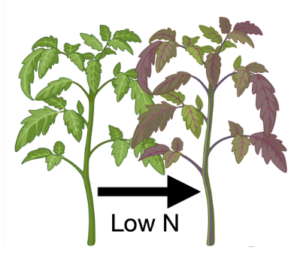
Image: Jacob Belding
Nitrogen mapping with sentinels
With their unique signaling ability, a whole field of sentinels would enable farmers to track nitrogen levels at every location in their field. However, because these plants are so new, there is currently no data on sentinel yield in a real-world field environment. Because sentinels must divert resources to produce their red pigment, planting them likely results in a noticeable yield decrease compared to non-sentinels. With this in mind, it would be more practical to distribute a few sentinels throughout the field rather than filling the entire field with sentinels. The sentinels will sample nitrogen values at strategic locations, and a statistical interpolation algorithm such as kriging can then estimate nitrogen levels for the whole field.
Like many other statistical techniques, kriging accuracy benefits from a large number of samples. However, in the case of nitrogen field mapping with sentinels, each additional sample comes with a yield cost. Farmers will refuse to adopt sentinels into their fields if the cost requirement is too high because of a large decrease in yield. Thus, the goal of my research project was to find the minimum sentinel planting density and ideal planting pattern for producing reliable field maps that can detect regions of nitrogen deficiency.
Planting sentinels and collecting data
Farmers’ fields can be hundreds of acres. If sentinels are planted, there needs to be an efficient way for farmers to collect all of the data. That’s where drone imagery comes in—vast amounts of information about a field can be collected through a single automated drone flight. One metric a drone can collect is Normalized Difference Vegetation Index (NDVI). A healthy green plant will have a high NDVI, while an unhealthy plant will have a low NDVI. For fields with sentinels, low nitrogen regions will also exhibit low NDVI because sentinels turn red under nitrogen stress.
Since NDVI and low nitrogen are closely linked and there is currently no drone data for sentinels, my research used NDVI collected from a real-world cotton dataset as a proxy for NDVI data collected from sentinels. The field pattern in the cotton dataset provided statistical parameters that allowed me to simulate a wide range of possible farmland conditions.
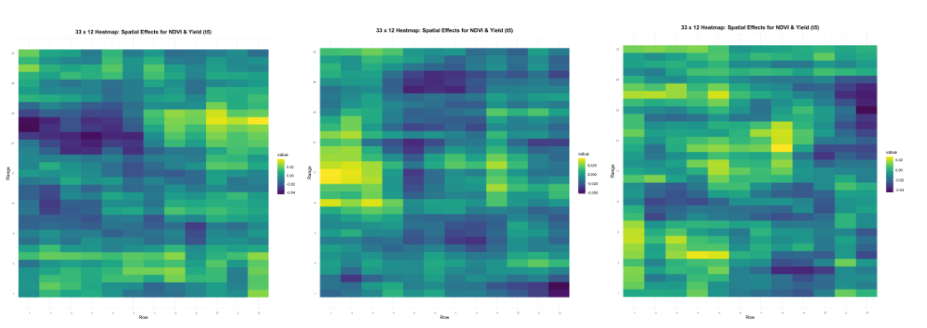
Image: Ankai Jin
Many methods exist for the planting pattern (or distribution) of sentinels. However, farmers’ fields are very large, so some distributions are impractical. For example, most tractors are not sophisticated enough to plant an evenly-spaced grid over hundreds of acres. Other methods, such as randomly distributing sentinels throughout the field, are more efficient. Farmers can mix sentinel seeds with non-sentinel seeds and plant them all at once. After planting, drones can then conduct imaging runs throughout the growing season—collecting NDVI and other crop health indicators.
After collecting crop health indicators, kriging can be used to generate a nitrogen field map. Kriging is a statistical technique that estimates values at unmeasured locations based on values at nearby measured locations. You can think of kriging as similar to a fill-in-the-blanks question on a test. Once an estimation is made for all unmeasured locations, the output is a kriging heatmap. With a kriging heatmap, accuracy metrics such as Root-Mean-Squared-Error (RMSE) and measures of correlation (R) can be deduced.
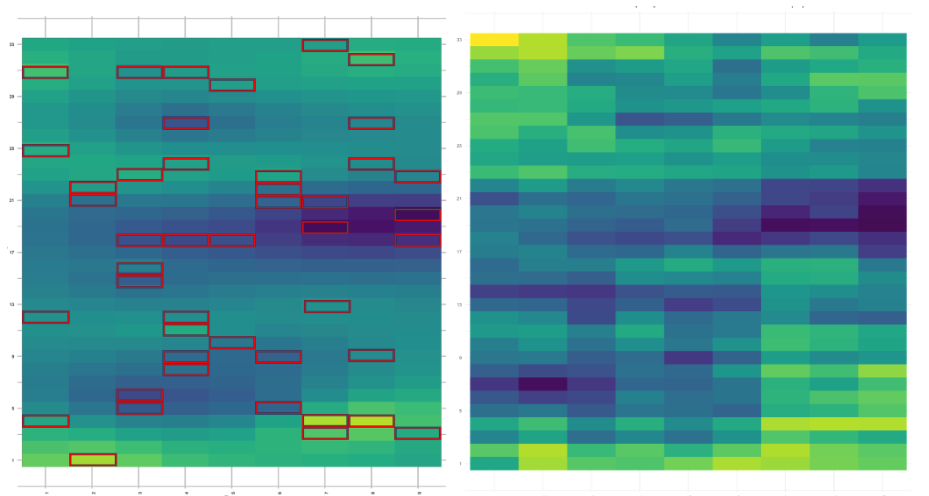
Image: Ankai Jin
The optimal density and distribution of sentinel plants
In my project, I generated kriging heatmaps from thousands of random field patterns, each with various distributions and densities of sentinels. I narrowed down my focus to two sentinel distributions, or planting patterns, that would be the easiest for farmers to implement: randomly planting sentinels throughout the field or planting sentinels in strips along the field.
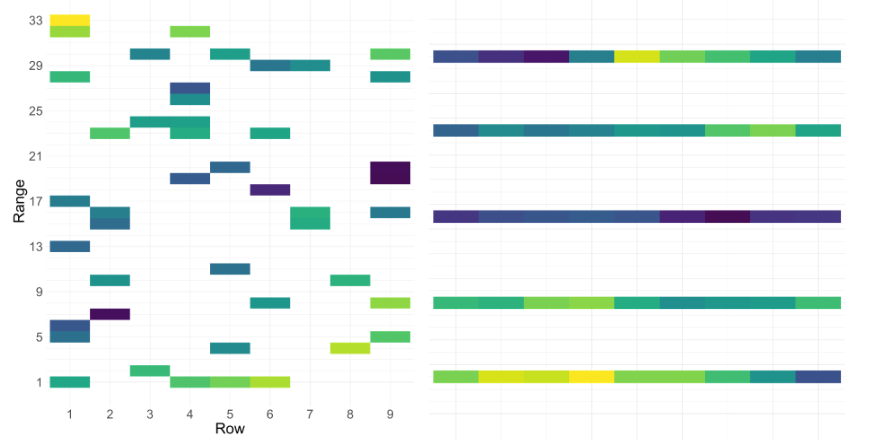
Image: Ankai Jin
To evaluate the performance of each distribution type, I focused on the R2 value between the kriging prediction heatmap and the field’s ground truth (or actual value). R2 is a decimal value that measures how well a model used for prediction fits the actual data. R2 values greater than 0.5 are often used as a rule of thumb to indicate strong model fit. My experiment was consistent with this benchmark—kriging maps with R2 > 0.5 could identify most significant regions of nitrogen deficiency or abundance.
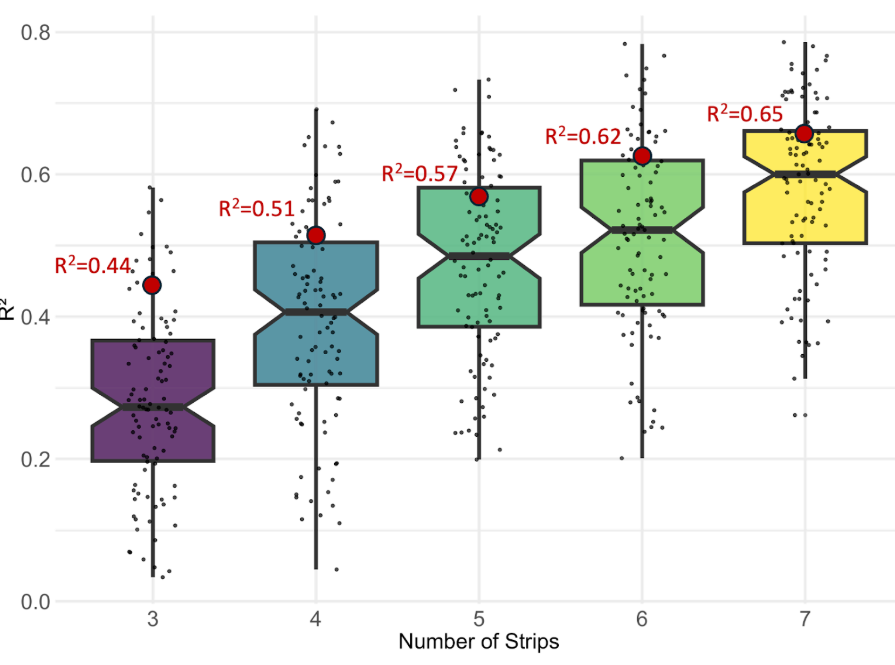
Image: Ankai Jin
After hundreds of repeated trials, planting sentinels in a random pattern consistently outperformed planting sentinels in strips. With a random distribution, sentinels only need to take up 12% of the field to achieve an average R2 of 0.5. For strip distributions, the required sentinel density is closer to 18%. Therefore, random distribution is most optimal because it achieves greater R2 values at lower sentinel densities.
In addition to kriging accuracy, another statistic to consider is the kriging failure rate. This statistic reflects the likelihood of the kriging algorithm failing due to a mathematical error when calculating the prediction map. For farmers, kriging failures would have serious consequences because sentinels cannot be relocated after planting. In the event of a kriging failure, the sentinels in the field would become obsolete. In addition to the expected yield hit from planting sentinels, farmers would not be able to reap the benefits that sentinels provide. Therefore, it is essential to keep the kriging failure rate to a minimum.
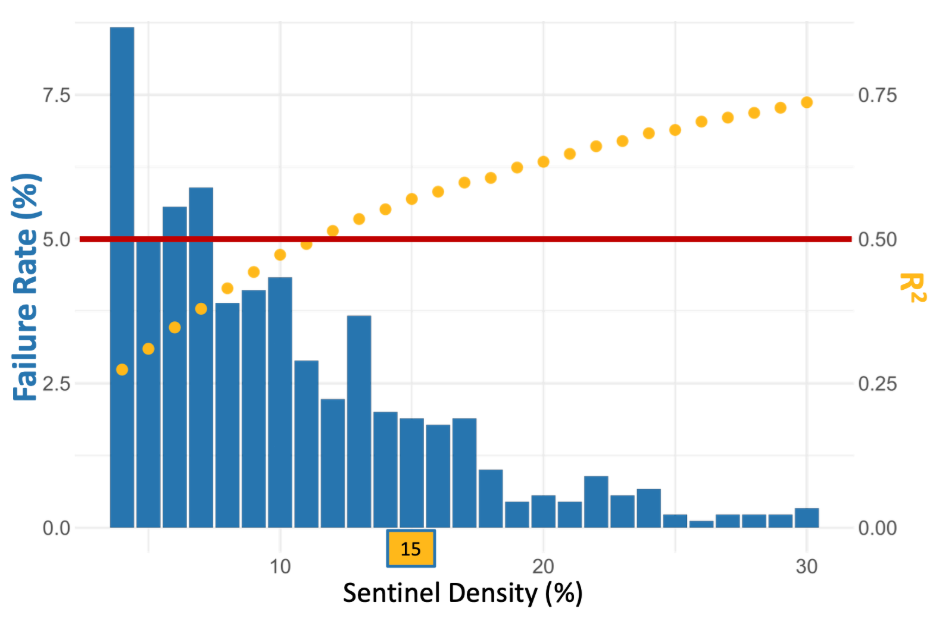
Image: Ankai Jin
From the graph above, we see that as the number of sentinels increases, the kriging failure rate decreases. The quality benchmarks in this experiment are represented by the red line: mean R2 greater than 0.5 and a kriging failure rate less than 5%. We found that 12% is the minimum density needed to achieve both of these benchmarks. However, in the real-world, sentinels will not be perfect reporters. Therefore, to account for small amounts of measurement error (~15%), we establish that the optimal sentinel density should be 15% for robustness.
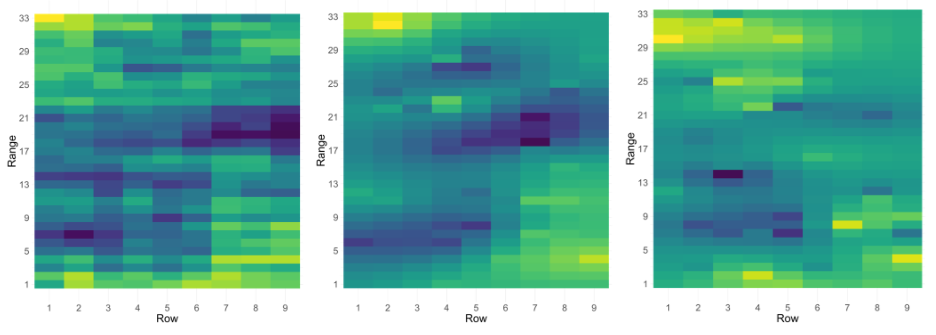
Image: Ankai Jin
Future directions
In agriculture, every plant counts. Farmers operate on small profit margins because much of the revenue from harvests is used to cover input costs such as seeds, fertilizer, and equipment. Through this pilot project, we established performance benchmarks for sentinels by understanding how measurement error and planting density affect nitrogen map quality. One benchmark, for example, is that farmers will need to exchange 15%—or nearly 1 in 6—of their high-yield crops for sentinels. Because this is a non-negligible portion of a farmer’s field, sentinels will need to meet certain yield and accuracy requirements to attain commercial viability. Determining the exact figures for viability is beyond the scope of this project and should be explored in future studies.
In the event that these yield and accuracy requirements are far from being reached, researchers could save millions of dollars by diverting resources towards other possible nitrogen runoff solutions. Ideally, sentinels can or are close to achieving the necessary requirements. Then, this project proves that sentinels are a working solution in theory and we can test whether this theory works in practice.
About the author

Hello readers! I am a rising third-year undergraduate computer engineering student at the University of California, Los Angeles (UCLA). In the Summer 2025, I worked as a research intern for the School of Integrative Plant Science at Cornell University. I was funded by the Center for Research on Programmable Plant Systems (CROPPS) and mentored by Professor Kelly Robbins and PhD student Dinesh Ghimire. Please reach out to me if you have any questions at atjin@ucla.edu. Thank you for reading about my research project and I hope you learned something new today!



